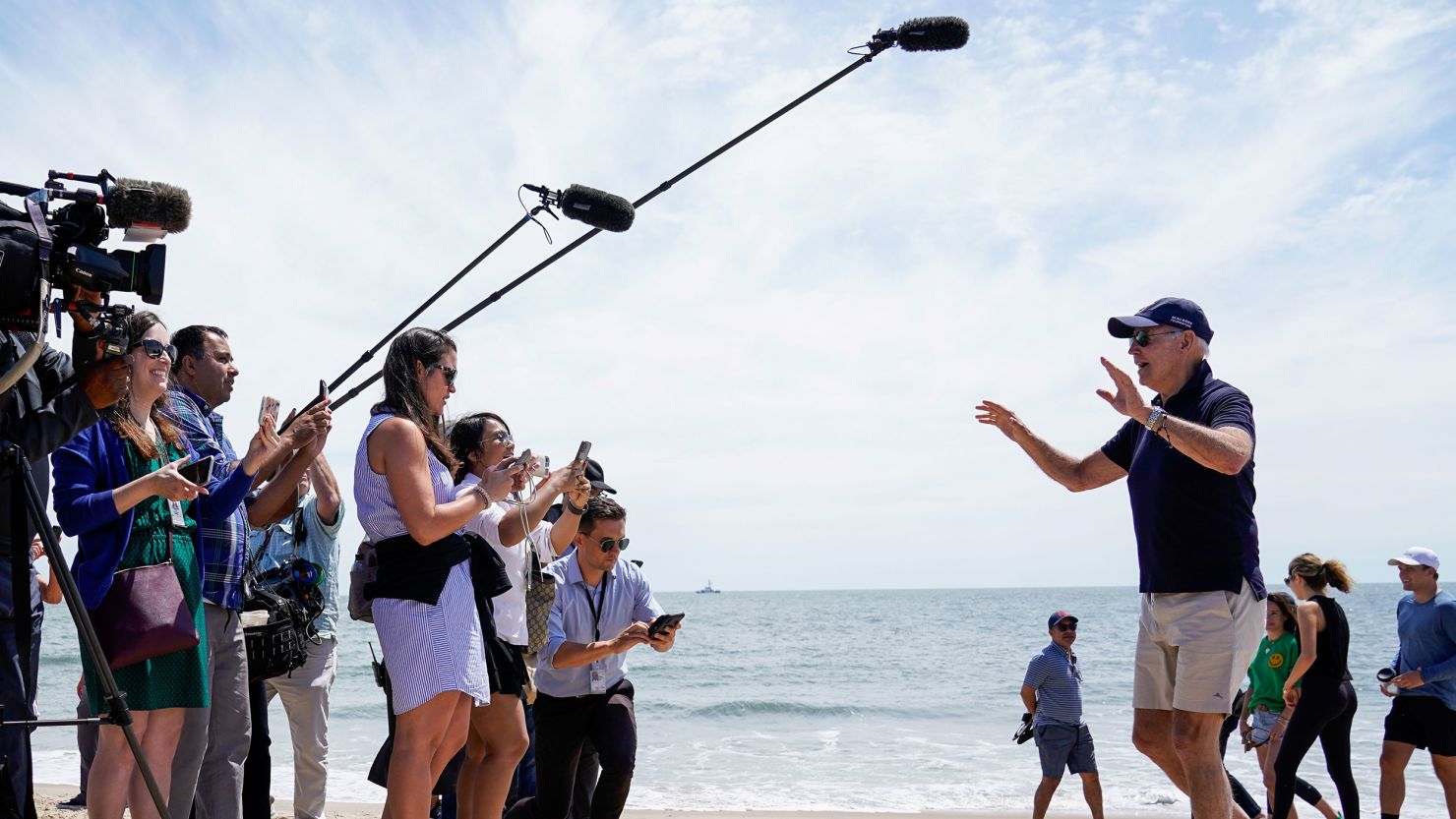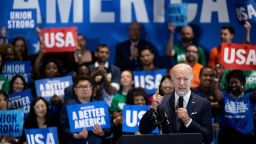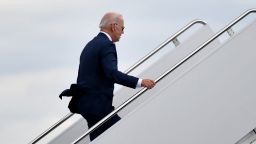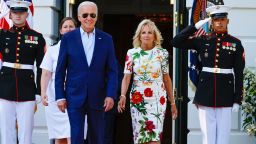President Joe Biden spent the weekend at his home in Delaware, where he met up with his wife, other family members and – if they followed usual practice – Willow the cat and Commander the dog.
It’s a familiar weekly ritual. As of this point in his presidency, Biden has spent more than a quarter of his time working from his home state of Delaware, either at his house in Wilmington or his Rehoboth Beach property.
Some 21 months into his term, Biden has made 55 visits to Delaware, totaling some or all of 174 days as of Sunday, according to a CNN analysis of presidential schedules and a tally kept by Mark Knoller, the longtime unofficial statistician of the White House press corps. In addition, Biden has made 19 visits, or all or part of 64 days, to the Camp David presidential retreat in rural Maryland.
He has now surpassed even the getaway time of former President Donald Trump, so often criticized by Democrats for his regular departures from the White House to stay at one of his personal homes. At this point in his tenure, Trump had spent about 135 days at either his Mar-a-Lago resort in Palm Beach, Florida, or his home at his golf club in Bedminster, New Jersey. Trump also had spent 23 days at Camp David.
“President Biden is deeply proud of his roots and his family and it has been a staple of his time in public life to never lose touch with either,” White House deputy press secretary Andrew Bates said to CNN. “Presidents of the United States are constantly on the job, regardless of their location – whether they’re on a state visit overseas or just 100 miles from the White House for a short trip to Wilmington, DE. And as all Americans can agree, it’s important for leaders to avoid becoming ensconced in Washington, DC.”
The comforts of home can be a salve for the commander in chief while carrying out one of the world’s most demanding jobs. The American president is never truly “off,” and – in fact – Biden, like all presidents, has a whole remote White House apparatus that travels with him to facilitate that round-the-clock enterprise, with the most state-of-the-art capabilities, resources and technology traveling with him wherever he goes.
Some argue that Biden can now lean into the normalcy of working from home, which millions of Americans had to rely on when Covid-19 forced isolation from offices and public spaces. “WFH” is not just a shorthand for being productive at the home office, it’s become a professional way of life for many.
“It is 2022, not 1922. If the rest of the country can work from home, so can the president of the United States,” said Michael LaRosa, a director at a DC-based public affairs firm and former press secretary to first lady Dr. Jill Biden.
“He spent (practically) every weekend in Delaware during his 36 years in the Senate, and his eight years as vice president,” LaRosa said. “This is nothing new. The Bidens have never lived in Washington, DC.” When he was a senator, Biden commuted back to Delaware almost every night by train – earning the nickname “Amtrak Joe” – and the train station in Wilmington is named for him.
The physical presence of a president is, however, meaningful for some, at least in ritual.
The statistics – 236 days away from the White House in Delaware and Maryland in less than two years on the job – are significant for the modern presidency. The job has been set in the nation’s capital near the Congress and the Supreme Court, in part for its symbolic power, for more than 220 years. Being in that power center brings a higher level of transparency thanks to the proximity to the national media, along with White House rules about press access and public records about who comes and goes.
Whenever the president is actually in the Oval Office, for example, that presence is honored by the solemn watch of a stone-faced US Marine posted outside the West Wing.
“A special challenge that Biden faces, because of his age, is that people will assume the worst if he’s not always visible. That is something that comes with being the oldest president in office,” said Tim Naftali, a CNN presidential historian, who notes presidents have had a “moveable Oval Office” for decades. “Perception is important in American politics.”
The optics of WFH or WFWH
A president of the United States who doesn’t consider the White House his primary home does not go unnoticed by the media, or critics. But the executive mansion’s primary residents have generally found it stifling.
“I always say I don’t know whether it’s the finest public housing in America or the crown jewel of the prison system,” former President Bill Clinton famously mused during a 1993 interview.
Knoller, who during his 32-year career with CBS News covered the personal habits of six presidents, concurs.
“It may look luxurious, but it can be suffocating to live and work there day in and out,” Knoller said.
Trump’s trips to Mar-a-Lago and Bedminster were fodder for op-eds and lent themselves to critics painting a portrait of a president unwilling to give up the trappings of a luxe off-duty lifestyle. And though many days were spent on the golf course – 125 or so at this point in Trump’s presidency, compared to Biden’s 19 on the links – Trump was still the leader of the free world. Biden’s former boss, Barack Obama, traveled home much less frequently while in office but was frequently dinged – by Trump, among others – for the amount of golf he played.
“(Ronald) Reagan and (George W.) Bush both spent lots of time at their private ranch homes,” said Knoller of two other former presidents who escaped the White House with regularity.
Knoller tabulated time away for presidents, he says, because the numbers “added color to my reporting and gave insight to the president’s needs and activities.”
According to Knoller’s count, George W. Bush spent all or part of 490 days – more than a year – at his Texas ranch during his eight years in office. Reagan spent nearly a year, all or part of 349 days, at his California ranch during his two terms. If Biden were reelected and kept up his current pace of trips to Delaware until the end of a second term in office, he would far surpass both Reagan and Bush in time away from the White House.
However, post-pandemic culture has blurred the boundaries of what defines a workplace.
“Our concept of being ‘on the job’ has shifted, and that may actually change the way we think about where our president needs to be,” Naftali said.
Some of Biden’s biggest political wins came this summer, after all, when he was isolating in the residence of the White House after testing positive for Covid-19. Photos showed him tie-less, often working in the second-floor Treaty Room or reading papers with his feet up on the Truman balcony, Commander by his side.
It was a view into what Biden’s work from home life may be like when he’s in Wilmington or Rehoboth.
“It’s a bit antiquated to think that because he is not physically in the White House on the weekends, that he is not working,” LaRosa said. “He never stops being President and he never stops working. Just ask the first lady.”
A weekly ritual
Biden has the advantage of a more normalized routine in his trips away from Washington.
The White House residence staff has by now perfected the choreography of managing, packing and planning the departure of the President and first lady most Fridays, the day, statistically, the Bidens normally split town.
The ushers know which bags are to be brought downstairs – it’s a light-pack, most of the couples’ needed belongings are already in their Delaware homes, a person familiar tells CNN. While Biden occasionally plays golf at a local course when in Wilmington, his other activities – seeing his grandchildren, taking casual social visits, going to church – don’t require multiple outfit changes.
In Rehoboth, he rides his bike and he and the first lady like to set up a big, blue umbrella on the sandy beach in front of their house and sunbathe or read in reclining chairs. Outside of swimsuits, joggers and polo shirts, it’s not a multiple-suitcase situation.
“The biggest issue is usually the pets,” said the person familiar with the weekend planning for a presidential getaway to Delaware.
Commander, now one year old and no longer a small puppy, and Willow, the barn cat adopted by Jill Biden, are “almost always” on the Delaware visits. While many American families leave their pets at home with caretakers for the weekend, or book them at pet-sitting facilities, the Bidens take theirs with them.
They like to be around their pets at all times – when Joe Biden was isolating at the White House with Covid-19 this summer, he was kept company by Commander; likewise, when Jill Biden had her bout with Covid, she spent the her rebound case isolation period in Rehoboth, with Willow.
The animals frequently travel to Delaware via van, with support staff, but occasionally they are in vehicles solely dedicated to their transportation, says the person. Willow, in particular, is not a fan of noisy, whirring helicopter blades, said another person familiar with the feline’s habits. In June, there was a rare sighting by White House press members of Willow in her crate, being carried by a residence staffer to Marine One for a weekend at Rehoboth Beach.
The Biden’s Delaware visits, of course, no matter how quick, have a significant footprint beyond those of the paws of their pets.
Secret Service coordinates with law enforcement on all movements – several highway exits must close for the presidential motorcade, locals in both Wilmington and Rehoboth must at times wait on traffic patterns or be swept by agents with handheld magnetometers just to walk down the beach if one of the Bidens is there, as one neighbor of the Bidens in Rehoboth Beach told CNN.
The large presidential apparatus helps ensure that the President is able to perform his duties with the full input of his advisers, even if they’re not with him in person.
“Unless we discover his being away from Washington results in him bobbling the ball as JFK did on the eve of the Bay of Pigs operation, there shouldn’t be an issue,” says Naftali, referring to Kennedy’s canceling of an air strike on a Sunday, without full consultation and full consideration, a move the former President later regretted.
“But if Biden is in touch virtually and telephonically, in this era, leadership doesn’t have to involve always being physically present in Washington, D.C.”









